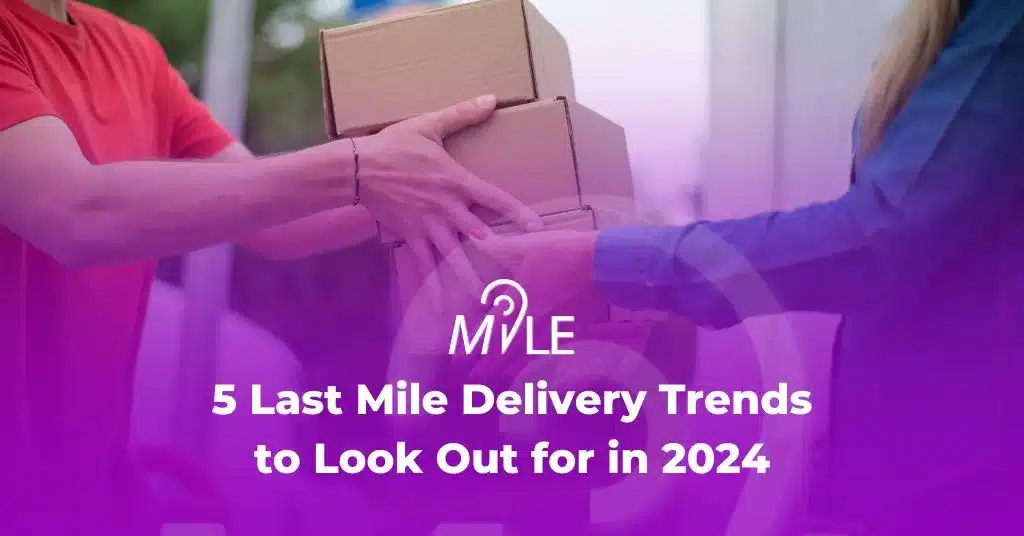5 Last Mile Delivery Trends to Look Out for in 2024

You’re probably already up to speed with the last mile delivery trends you can expect in 2024, if your business involves selling products directly to your end customers. On the off chance you aren’t, keep reading.
For the uninitiated, “last mile delivery” sometimes known as “final mile delivery”, is the last leg of a product’s journey from a warehouse (or fulfillment center) to the customer’s doorstep. In 2020, when online shopping and home delivery were at an all-time high, last mile delivery became substantially more important.
The reason is obvious. In the post-pandemic world, online shopping is one of the most convenient and health-friendly ways to buy anything. Millions of people across the globe now depend on eCommerce for their daily needs.
According to the latest statistics:
- The eCommerce market is projected to surpass $8 trillion by the year 2027.
- Approximately 79% of consumers make online purchases at least once every month.
- Over 90% of shoppers track their packages actively.
- Roughly 60% of shoppers choose retailers that offer delivery options that meet their needs – convenience, speed, or a combination of the two.
- Nearly 50% of shoppers won’t return to online stores that deliver their orders late.
- The last mile delivery market is estimated to exceed $200 billion by 2027.
That said, several issues related to last mile delivery impact customer satisfaction and business profitability. For example, online shoppers often pay additional money if they want faster delivery, and they don’t forgive poor service even if their shipping costs increase.
Moreover, rising global inflation is driving up the already high cost of last mile delivery, which accounts for 53% of overall shipping costs. As eCommerce expanded its scope over the last few years, so did the third-party logistics providers (3PLs) that, despite bridging service quality gaps, made order fulfillment more expensive and complex for retailers. This complexity combined with the the exponential growth of eCommerce and consumers’ preferences, on the one hand, sped up automation of routine online retail workflows, and on the other, triggered a corresponding digital transformation in last mile delivery operations.
As we enter the new year, let’s take a look at the last mile delivery trends eCommerce brands and 3PLs are most likely to adopt to stay ahead of the curve.
5 Last Mile Delivery Trends That Will Dominate in 2024
Adoption of Quick Commerce Model
In the world of eCommerce, quick ecommerce has revolutionized the on-demand delivery industry, especially in the pharmaceutical, grocery, and online retail sectors. Branded and company executives are transforming their traditional ways of doing business with digital transformation due to technological advancements. Consumers want their purchases to be delivered on time.
Customers are looking for convenience more than ever. Over 70% of customers consider delivery flexibility to be necessary. In the last-mile delivery business, same-day and next-day deliveries are anticipated to occur significantly. The quick commerce approach has aided firms in taking advantage of various delivery methods, including on-demand delivery and fast deliveries. Businesses focus on establishing remote warehouses and developing innovative technologies for faster deliveries, SLAs, and rapid order fulfillment.
Implementation of Last Mile Logistics System
Of all the steps in a delivery workflow, last mile is often the most time-consuming and expensive. Thankfully, AI-powered last mile logistics softwares have become a solution of choice for ensuring fast and seamless logistics operations. Mile’s delivery management software, for example, has built-in features such as predictive dispatch, live tracking & replay, route optimization, predictive load analysis, warehouse stock & returns management, and native apps for merchants, customers, and delivery drivers, to facilitate handling last mile shipments with greater accuracy and efficiency. The software also incorporates digital features like electronic proof of delivery (ePOD), electronic signatures, and contactless payments, and thus, minimizes the need for paper-based documentation and physical contact.
Delivery With Drones & Autonomous Robots
The sheer number of deliveries happening daily across the world is mind-boggling. As worldwide delivery volumes rise, it’s become increasingly essential to switch to new-age, robotic deliveries. It’s little wonder that retailers and last mile delivery firms have begun to experiment with advanced delivery technologies involving drones, autonomous delivery robots, and self-driving vehicles.
Purchasing robotic delivery systems appears to be a significant investment, but a one-time expense can pay you off for years. Amazon’s investment in Aurora, a self-driving car firm, is a notable example.
Focus on Eco-Friendly Deliveries
Along with an emphasis on ensuring on-time, in-full last mile deliveries, it’s critical to pay attention to the environmental friendliness of delivery services. Over the previous few years, eCommerce and logistics companies have become increasingly concerned about green logistics and sustainable delivery methods. The aim is to minimize greenhouse gas emissions by 99 percent.
Many businesses are trying to provide environmentally-friendly delivery processes by utilizing reusable packaging material and reducing carbon dioxide emissions generally created by delivery trucks. DHL and Safexpress are embracing electric vehicles a chance to benefit deliveries.
Multiple Delivery Options
Retail Week reports that seven in ten consumers prefer to buy from retailers that offer a range of customized delivery options. Broadly speaking, there are two main categories of last mile deliveries:
- Scheduled: Customers choose a specific delivery time for up to seven days in advance. Once scheduled, couriers or 3PLs use route optimization software to create journey plans for their delivery fleet. This process considers various factors, including transit time, vehicle capacity, inventory levels, driver experience, and any specific qualifications required.
- On-demand: This allows customers to have their order delivered within the shortest delivery time possible. Although delivering each order individually without a proper route plan increases costs for carriers or logistics providers, it fosters trust and loyalty from the customer’s standpoint as their orders are fulfilled the same day or even minutes after they place them.
Research indicates a growing trend among eCommerce retailers and delivery firms introducing multiple delivery options. This approach not only enables them to cater to customers with varied preferences but also safeguards the business against the pitfalls of relying too heavily on a single delivery method.
Final Thoughts
2024 has just begun and the last mile delivery trends mentioned above have already become popular in the eCommerce and delivery business sectors. Don’t be left behind! Book a demo with Mile and get onto automating your last mile delivery operations right away.
Read More: Platform For Delivery Management: Get More Done In The Last Mile
